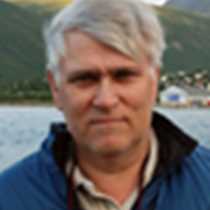Danger Islands and Paulet, Weddell Sea
Today we dedicated our exploration to icebergs. The Weddell Sea stands out as the quintessential for ice, icebergs and pack-ice drifting in the ocean. The clockwise Weddell Sea gyro captures not only the huge tabular icebergs but also the pack-ice, which throughout the summer breaks up. Some of the tabular icebergs break off from the Larsen and Ronne Ice Shelf in the southern parts of the Weddell Sea, but because of the prevailing east drift along the Antarctic Continent, some of the icebergs we encountered today may have drifted from the opposite side of Antarctica, the Ross Sea.
As we sailed along the sea was cluttered with icebergs and very rapidly your imagination starts to see pictures, sculptures and even faces and even people you recognize carved into their surface. It is just a matter of how far you want to let your imagination go!
Suddenly Amundsen’s face with his characteristic nose was standing beside our ship, maybe to connect with the 100-year celebration of his reaching the South Pole with his men and their dogs. On this day 100 years ago he and his men were already heading for home, Framheim at Bay of Whales on the Ross Ice Shelf. By this time they had already left the very cold and hostile Polar Plateau behind, while Scott and his men still were struggling to reach the ultimate point, S90o.
For us the day was very much about iceberg photography and the opportunities were endless! Still we also had many more events to enjoy and in the morning we tried to make it to a group of islands, very properly named Danger Islands. They are located in a shallow area of the Weddell Sea surrounded with heavy currents, underwater rocks and pack ice. As we approached we were able to see whirlpools caused by the riptide. Danger Island was named by James Ross as he sailed by with his ships Erebus and Terror 1842.
The islands are most likely the home of one of the largest concentration of breeding Adelie penguins in the world! Until now, 2012, no one has ever been able to fully census all islands, due to their remoteness. Our aim was to make a Zodiac cruise along Heroina Island, one of the islands in the archipelago and named after an Argentinean research ship. The number of Adelie penguins on just this one island have been estimated to 300,000 pairs. The other islands are like to hold at least the same numbers or even more. Danger Islands could be called the “Forgotten Islands” when it comes to Adelie penguins because of their inaccessibility. It is rare to get here and even more rare to get ashore. At least we tried.
Today it was not the ice that made it impossible. It was the wind and swell. Instead we set our course for Paulet Island, also known to be home to huge numbers of breeding Adelie Penguins. Ashore in the afternoon we found ourselves amongst maybe 80,000 pairs of penguins. Most of the chicks were starting to cresh. The number of penguins walking up and down from the colony to the beach and back was endless. The need to feed and find more food for their ever-hungry chicks had become compulsive behavior. It is a busy place but only for a short time, and by late summer all birds will disappear and it will become a very quiet place again.
In late February 1903, 22 men from the ship Antarctica arrived to the same place. Their ship had been crushed by the ice but luckily Captain Larsen knew about Paulet Island. They were able to salvage provisions and tools before the ship sank and managed to drag all this equipment over the ice to Paulet. As it was the end of summer about 1500 penguins were still left on the Island. They became both food and fuel for the men to survive the hardship of the winter of 1903, living in the stone hut they built.
Very few remains can be found in Antarctica today from the Heroic Age of exploration but this hut is one of them. Twelve years later, an Englishman more or less had the same experience in the Weddell Sea with ice crushing his ship. He tried to reach the same hut but later ended up at Elephant Island. This is of course a different story to tell about the Heroic Age. Still today the Weddell Sea with its immense ice gyro is a challenge for any ship to penetrate but we were lucky to see some of this area very few ever get to glance with their eyes.
After dinner we enjoyed a fantastic movie the Follett clan onboard brought to share. Their grandfather was down to Antarctica, October and November 1963 and the movie was very much a time capsule going back almost 50 years ago. Later through the night we set sail for the western side of the Peninsula, through Antarctic Sound named after the ship Antarctica, Captain Larsen and Nordenskiöld used for the Swedish Antarctic Expedition 1901-1904, one of the many stories from the Heroic Age.




